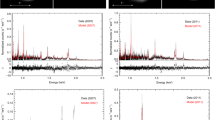Abstract
Supernovae launch spherical shocks into the circumstellar medium (CSM). These shocks have high Mach numbers and may be radiative. We have created similar shocks in the laboratory by focusing laser pulses onto the tip of a solid pin surrounded by ambient gas; ablated material from the pin rapidly expands and launches a shock through the surrounding gas. Laser pulses were typically 5 ns in duration with ablative energies ranging from 1–150 J. Shocks in ambient gas pressures of ~1 kPa were observed at spatial scales of up to 5 cm using optical cameras with schlieren. Emission spectroscopy data were obtained to infer electron temperatures (< 10 eV).
In this experiment we have observed a new phenomena; at the edge of the radiatively heated gas ahead of the shock, a second shock forms. The two expanding shocks are simultaneously visible for a time, until the original shock stalls from running into the heated gas. The second shock remains visible and continues to expand. A minimum condition for the formation of the second shock is that the original shock is super-critical, i.e., the temperature distribution ahead of the original shock has an inflexion point. In a non-radiative control experiment the second shock does not form. We hypothesize that a second shock could form in the astrophysical case, possibly in radiative supernova remnants such as SN1993J, or in shock-CSM interaction.
Similar content being viewed by others
References
Müller, E., Fryxell, B. and Arnett, D.: 1991, A&A 251, 505.
Reed, J.I., Hester, J.J., Fabian, A.C. and Winkler, P.F.: 1995, ApJ 440, 706.
Sonneborn, G., Pun, C.S.J., Kimble, R.A., Gull, T.R., Lundqvist, P., McCray, R., Plait, P., Boggess, A., Bowers, C.W., Danks, A.C. et al.: 1998, ApJ Lett. 492, L139.
Remington, B.A., Arnett, D., Drake, R.P. and Takabe, H.: 1999, Science 284, 1488.
Bartel, N., Bietenholz, M.F., Rupen, M.P., Beasley, A.J., Graham, D.A., Altunin, V.I., Venturi, T., Umana, G., Cannon, W.H. and Conway, J.E.: 2000, Science 287, 112.
McKee, C.F. and Draine, B.T.: 1991, Science 252, 397.
Allen, D.A. and Burton, M.G.: 1993, Nature 363, 54.
Klein, R.I. and Woods, D.T.: 1998, ApJ 497, 777.
Blondin, J.M., Wright, E.B., Borkowski, K.J. and Reynolds, S.P.: 1998, ApJ 500, 342.
Bozier, J.C., Thiell, G., LeBreton, J.P., Azra, S., Decroisette, M. and Schirmann, D.: 1986, Phys. Rev. Lett. 57, 1304.
Grun, J., Stamper, J., Manka, C., Resnick, J., Burris, R., Crawford, J. and Ripin, B.H.: 1991, Phys. Rev. Lett. 66, 2738.
Ryutov, D., Drake, R.P., Kane, J., Liang, E., Remington, B.A. and Wood-Vasey, W.M.: 1999, ApJ 518, 821.
Shigemori, K., Ditmire, T., Remington, B.A., Yanovksy, V., Ryutov, D., Estabrook, K.G., Edwards, M.J., MacKinnon, A.J., Rubenchik, A.M., Keilty, K.A. and Liang, E.: 2000, ApJ 533, 159.
Robey, H.F., Kane, J.O., Remington, B.A., Drake, R.P., Hurricane, O.A., Louis, H., Wallace, R.J., Knauer, J., Keiter, P., Arnett, D. and Ryutov, D.D.: 2001, Phys. Plasmas 8, 2446.
Fleury, X., Bouquet, S., Stehle, C., Koenig, M., Batani, D., Benuzzi-Mounaix, A., Chieze, J.-P., Grandjouan, N., Grenier, J., Hall, T. et al.: 2002, Laser Part. Beams 20, 263.
Keiter, P.A., Drake, R.P., Perry, T.S., Robey, H.F., Remington, B.A., Iglesias, C.A., Wallace, R.J. and Knauer, J.: 2002, Phys. Rev. Lett. 89, 165003.
Taylor, G.I.: 1950, Proc. R. Soc. London A 201, 159.
Sedov, L.I.: 1959, Similarity and Dimensional Methods in Mechanics, Academic Press, New York.
Zeldovich, Y.B. and Raizer, Y.P.: 1966, Physics of Shock Waves and High-Temperature Hydrodynamic Phenomena, Academic Press, New York.
McKee, C.F. and Ostriker, J.P.: 1977, ApJ 218, 148.
Zimmerman, G.B. and Kruer, W.L.: 1975, Comments Plasma Phys. Controlled Fusion 2, 51.
Mihalas, D. and Mihalas, B.W.: 1984, Foundations of Radiation Hydrodynamics, Oxford University Press, Oxford.
Barenblatt, G.I.: 1979, Similarity, Self-Similarity and Intermediate Asymptotics, Consultants Bureau, New York.
Reinicke, P. and Meyer-ter-Vehn, J.: 1991, Phys. Fluids A 3, 1807.
Author information
Authors and Affiliations
Corresponding author
Rights and permissions
About this article
Cite this article
Hansen, J.F., Edwards, M.J., Froula, D. et al. Laboratory Simulations of Supernova Shockwave Propagation. Astrophys Space Sci 298, 61–67 (2005). https://doi.org/10.1007/s10509-005-3912-6
Received:
Accepted:
Issue Date:
DOI: https://doi.org/10.1007/s10509-005-3912-6




